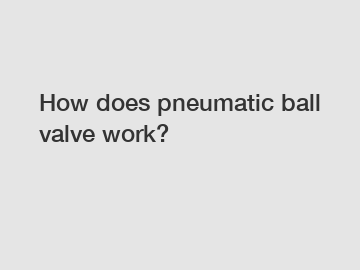How does pneumatic ball valve work?
How Does a Pneumatic Ball Valve Work?
Pneumatic ball valves are widely used in various industries, including oil and gas, chemical, power, water treatment, and many more. These valves play a vital role in controlling the flow of fluids or gases in a pipeline. If you are curious about how pneumatic ball valves work, this article will provide you with a comprehensive understanding of their mechanisms and operations.
What is a Pneumatic Ball Valve?

A pneumatic ball valve is a type of valve that uses compressed air to control the opening and closing of a ball inside the valve body. The ball has a hole or port in the center that allows or blocks the flow of fluid or gas. When the valve is open, the hole aligns with the pipeline, enabling the fluid or gas to flow. Conversely, when the valve is closed, the ball rotates 90 degrees, blocking the flow and preventing leakage.
Primary Components of a Pneumatic Ball Valve.
1. Actuator: The actuator is responsible for converting the energy of compressed air into mechanical motion. It opens or closes the valve by either extending or retracting a piston or diaphragm.
2. Ball: The ball inside the valve body has a hole or port in the center. It controls the flow of fluid or gas by rotating 90 degrees between the open and closed positions.
3. Valve Body: The valve body provides the housing and support for the other components. It is typically made of materials such as stainless steel, brass, or carbon steel, depending on the application and the fluids or gases being controlled.
4. Stem: The stem is connected to the ball and extends outside the valve body. It transmits the motion from the actuator to the ball, allowing it to rotate.
The Operation of a Pneumatic Ball Valve.
When a control signal is sent to the actuator, it either opens or closes the valve. Let's understand the operation of a pneumatic ball valve in both scenarios:
1. Opening the Valve: When the control signal indicates the valve to open, compressed air enters the actuator, causing the piston or diaphragm to extend. As a result, the stem connected to the actuator moves upward, rotating the ball by 90 degrees. The hole in the ball aligns with the pipeline, allowing the fluid or gas to flow freely.
2. Closing the Valve: Similarly, when the control signal commands the valve to close, compressed air enters the actuator in the opposite direction. The piston or diaphragm retracts, and the stem moves downward. This motion rotates the ball back by 90 degrees, aligning the solid part of the ball with the pipeline and blocking the flow of fluid or gas.
Advantages of Pneumatic Ball Valves.
Pneumatic ball valves offer several advantages over other types of valves, such as:
1. Quick and reliable operation: Pneumatic ball valves respond rapidly to control signals, allowing for efficient valve operation.
2. Tight sealing: When in the closed position, the ball of a pneumatic ball valve provides a reliable and tight seal, minimizing the risk of leakage.
Want to Learn More?
If you would like to learn more about pneumatic ball valves or need assistance in selecting the right valve for your application, please feel free to contact us. Our team of experts is always ready to help you find the best solution for your fluid or gas control needs.
In conclusion, pneumatic ball valves are essential components in various industrial processes where precise control of fluid or gas flow is required. By understanding their mechanisms and operations, you can make informed decisions when it comes to selecting and utilizing these valves in your applications. So, next time you encounter a pneumatic ball valve, you will have a better understanding of how it works. Contact us today for any queries or assistance in choosing the right pneumatic ball valve for your requirements.
For more gg40 butterfly valve, ship valves, qingdao great valves co., ltd.information, please contact us. We will provide professional answers.


